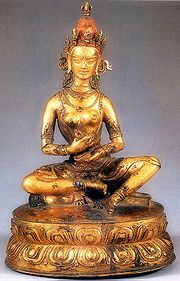Nairatmya

Nairātmyā or Dagmema (Wylie: bdag med ma) is a yoginī, the consort of Hevajra in the Hevajra-tantra. The name means "she who has no self (ātman)". Nair-ātmyā is the feminine form of nairātmya which comes from nirātman (the Sanskrit negative particle "niḥ" combined with the masculine noun for self-"ātman"); nairātmya means "of nirātman", and in the feminine form, nairātmyā, "she who has no self". Nair-ātmyā, the no-self female, that is, she who has no self. She is an embodiment of the Buddhist philosophical concept of anātman (anatta in Pāli).
